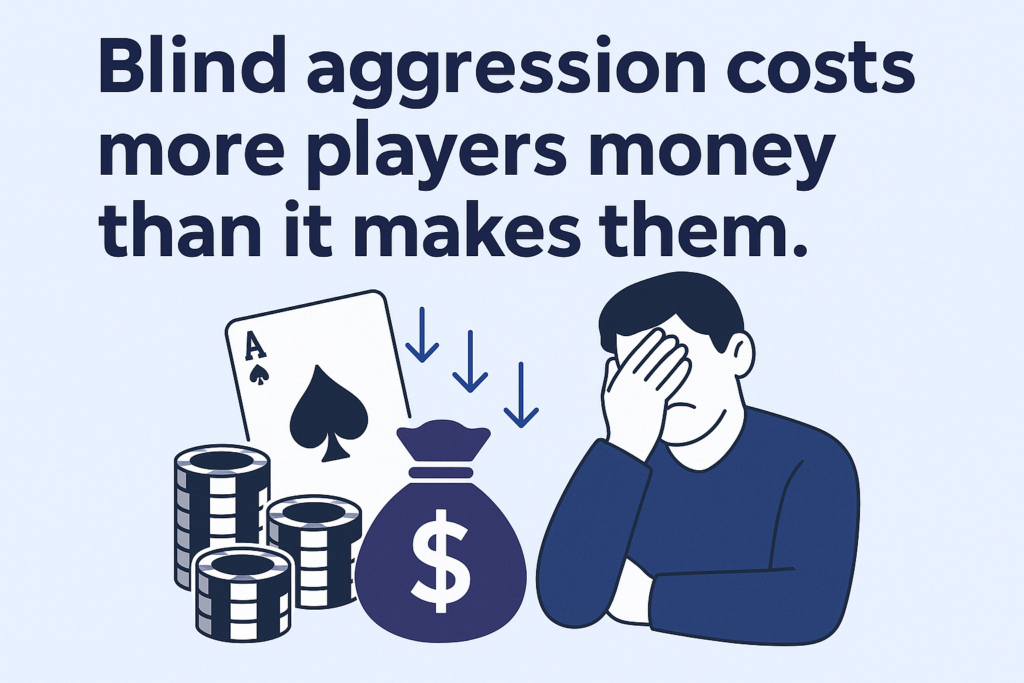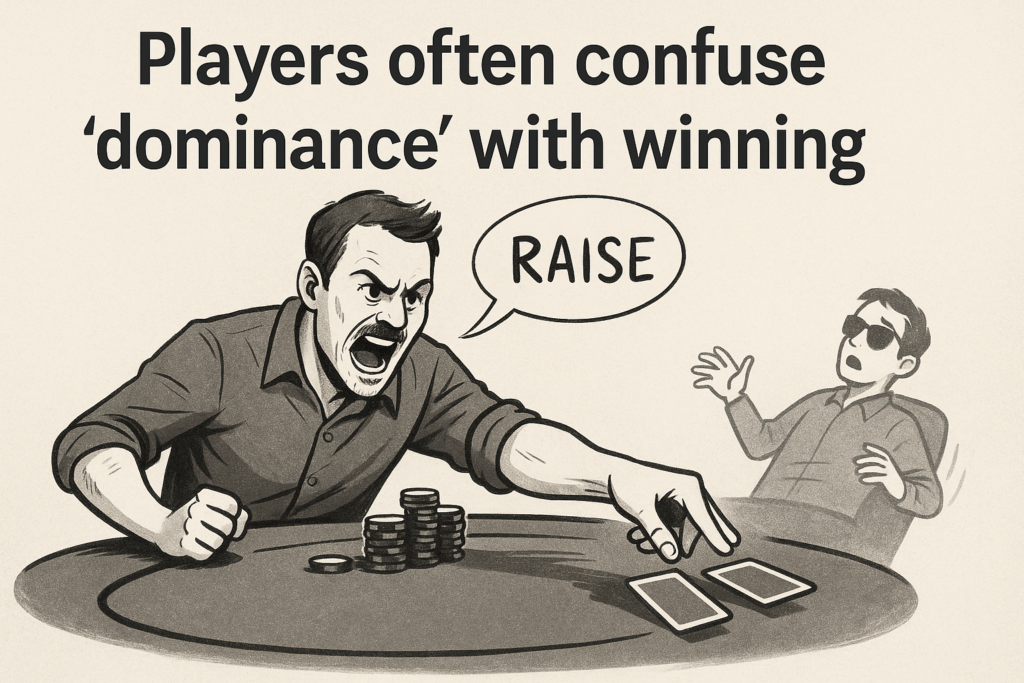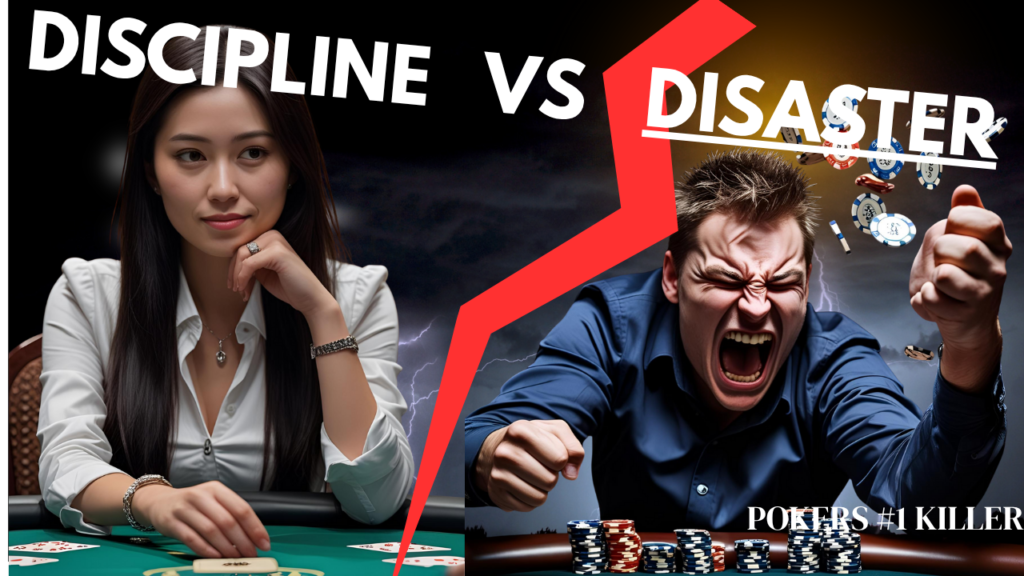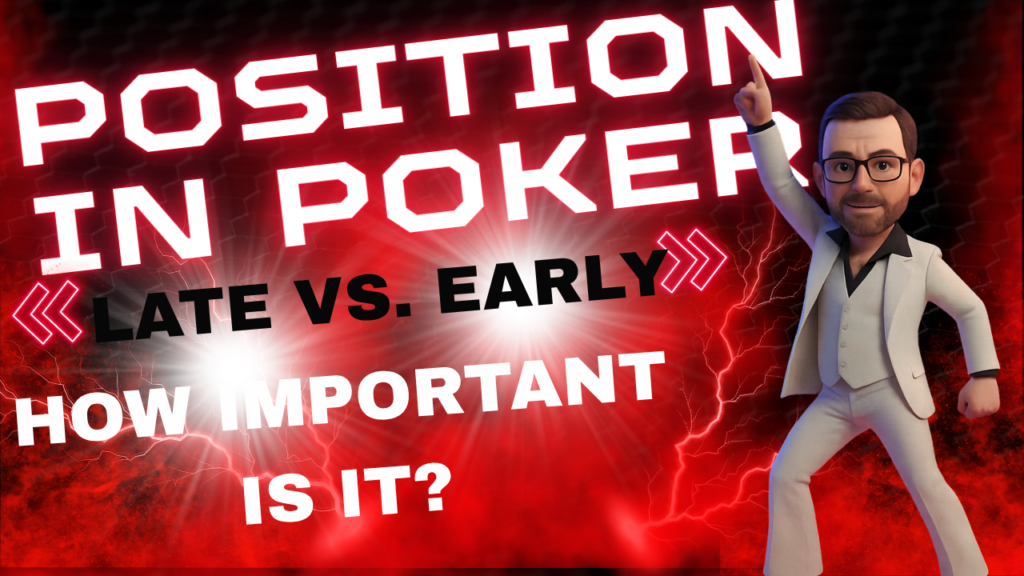AGGRESSION IN POKER
THE AIKIDO APPROACH TO WINNING
THE MYTH OF CONSTANT AGGRESSION
In almost every poker book, forum, or video, one mantra keeps getting repeated:
“Aggression In Poker should be constant.”
“Always be aggressive. Aggression always wins.”
It’s advice born out of TV poker highlight reels—big bluffs, massive pots, players hammering the table with relentless bets until their opponents crumble. Over time, this one-dimensional idea became gospel, taught as if constant aggression is the only winning poker strategy.
But the truth is, blind aggression costs more players money than it makes them. It builds bloated pots you can’t win, pushes hands that never should have been played, and leads to tilt-fueled disasters.

Poker isn’t a game of brute force. It’s a game of timing, precision, and control. And that’s where Aikido—the Japanese martial art focused on using an opponent’s energy against them—offers a powerful lesson for the poker table.
Aikido doesn’t teach fighters to overpower their opponents. It teaches them to redirect force, stay balanced, and win without unnecessary conflict. The same principle applies to poker:
True mastery doesn’t come from hammering every pot—it comes from knowing when to strike, when to wait, and how to let others defeat themselves.
This article explores a better poker aggression strategy—one built on self-control, harmony with the table, and purposeful action. Using the wisdom of Aikido, we’ll break down why constant aggression is a leak, how patience can be a weapon, and why true power at the table comes from control, not chaos.
POKER AGGRESSION STRATEGY STARTS WITH SELF-CONTROL
Before you can control a table, you have to control yourself. Aikido teaches that true victory begins within. Without balance and self-mastery, you can’t read or redirect anyone else’s energy. In poker, the same truth holds: the biggest leaks in aggression come from inside, not from bad luck or bad opponents.
How many times have you shoved chips into a pot just to “prove you’re not folding everything”? How many bluffs have you fired simply because you were frustrated, bored, or chasing a lost hand? These aren’t calculated moves—they’re emotional reactions, and they bleed money faster than any other leak in the game.
Psychology backs this up. Decision fatigue—the mental drain from making choice after choice—erodes patience and discipline as a session drags on. Baumeister’s research on willpower depletion shows that even skilled decision-makers lose impulse control when mentally taxed. Add a few bad beats or hours of folding junk hands, and suddenly “being aggressive” feels like the only way to “take control” again.
But real control isn’t about forcing action. It’s about staying centered—mathematically, emotionally, and strategically—even when the game feels like it’s slipping away. The best poker aggression strategy doesn’t start with betting more. It starts with mastering yourself:
- Knowing that folding for an hour isn’t weakness—it’s discipline.
- Recognizing that tilt is just ego, not an excuse to push chips in bad spots.
- Accepting that not every battle is worth fighting, no matter how badly you want to win one.
In Aikido, you can’t redirect an opponent’s force if you’re already off balance. At the poker table, you can’t apply profitable poker aggression if you’re chasing losses or playing emotionally. True victory comes first from calmness and patience, then from action rooted in sound strategy.
SIDEBAR: THE PSYCHOLOGY BEHIND LOSING SELF-CONTROL IN POKER
Even the best poker players aren’t immune to mental fatigue. Science shows that bad aggression often has nothing to do with skill—it’s about what your brain does after hours of decisions, stress, and frustration.
DECISION FATIGUE
EGO DEPLETION
Studies show that making decision after decision—whether it’s what to eat, what emails to answer, or which poker hands to play—wears down your mental stamina. By the end of a long session, your ability to evaluate risk and stay disciplined drops significantly (Vohs et al., 2008).
Roy Baumeister’s research on willpower shows that self-control is a limited resource. Every time you resist tilting, fold a bad hand, or avoid chasing a loss, you use a bit of that energy. When it runs out, emotions take over and reckless aggression follows.
HARMONIZING AGGRESSION IN POKER - THE PRINCIPLE OF ONENESS
In Aikido, the principle of oneness means blending with your environment and opponents, not clashing against them. You don’t fight every force head-on; you flow with the situation, using its energy to your advantage. In poker, the same truth applies: aggression in poker works best when it’s in harmony with the table’s rhythm—not forced just because you feel like it’s “your turn.”
Players often confuse dominance with winning. They think raising every pot or bullying a passive table makes them the “alpha.” But real poker aggression strategy isn’t about dominance—it’s about timing and context. When the entire table is loose and wild, forcing aggression only builds huge pots you can’t control. When the table is tight and cautious, blind aggression is wasted because nobody’s giving action.

Harmony with the table means observing:
- Who’s loose and calling light?
- Who’s playing snug and waiting for premiums?
- Who’s on tilt, trying to get even?
- How has your own image shifted in their eyes over the past hour?
Just like Aikido teaches you to blend with the flow of an attack before redirecting it, poker demands awareness before action. The best aggression is not constant—it’s invisible until the perfect moment, when it feels natural to the table and unavoidable to your opponents.
SIDEBAR: THE PSYCHOLOGY OF TABLE DYNAMICS IN POKER
Humans unconsciously adapt to the “group mood” at any table—a phenomenon explained by:
EMOTIONAL CONTAGION
MIRROR NEURONS
POKER IMPLICATION
People absorb the feelings and energy of others around them (Hatfield, Cacioppo, Rapson, 1994). If the table is tense, cautious play spreads. If it’s loose, aggression spreads just as easily.
Our brains literally “mirror” observed behaviors, making it hard not to match the table’s pace. This can trick players into mistaking speed and frequency for strength, leading to ill-timed aggression.
Recognizing this herd effect keeps you from making reactive plays just to “keep up.” True strategy is adjusting to the flow, then choosing when to break it for maximum profit.
CIRCULAR MOTION - REDIRECTING OPPONET'S AGGRESSION IN POKER
In Aikido, a direct clash of force against force rarely works. Instead, you step slightly aside, guide the opponent’s energy, and let their own momentum unbalance them. The stronger their charge, the harder they fall.
Poker aggression works the same way. The table maniac raising every hand? The LAG barreling three streets with air? You don’t need to “fight back” by getting louder and more aggressive yourself. In fact, most players lose money trying to “reclaim control” against someone throwing chips around recklessly.
The smarter play is to redirect their force. Let them do the betting, let them build the pot, and let their overconfidence walk them right into a trap. The circular motion in poker isn’t about spinning chips—it’s about guiding their poker aggression into a line where you have them dominated.
Example:
- A LAG player opens wide, you flat with a strong hand in position instead of 3-betting.
- They continue firing on flop and turn.
- By the river, they’ve built a massive pot you didn’t have to risk anything to inflate—and now you stack them with the nuts while they’re still convinced they can bluff you off a hand.
This isn’t passive. It’s precision timing, letting their energy do your work for you, then stepping in only when the math, position, and odds are all in your favor. True poker aggression strategy doesn’t mean fighting every battle. It means choosing battles you’re guaranteed to win.
SIDEBAR: WHY OVER-AGGRESSIVE PLAYERS SELF-DESTRUCT
OVERCONFIDENCE BIAS
HOT-HAND FALLACY
LOSS AVERSION
POKER IMPLICATION
Aggressive players often overestimate their ability to push opponents off hands, ignoring math and table image.
After winning a few pots, they believe they’re “unbeatable,” leading to wider and riskier plays.
Once they start losing, they keep firing—betting more aggressively to “win it back,” digging deeper holes.
You don’t need to crush their aggression with your own. You just need to wait, guide, and capitalize when their emotional leaks hit critical mass.
LETTING THE AGGRESSOR COME TO YOU - THE POWER OF PASSIVE TRAPS
In Aikido, you don’t meet force with force. You don’t rush the attacker. You let them commit first, step slightly off the line of attack, and use their own energy to defeat them. The principle is simple: why expend energy when your opponent is already giving you everything you need to win?
Poker players often misunderstand this. They think that if they’re not pushing the action, they’re playing weak. But real strength is knowing when to hold fire and let others make mistakes for you.
Think about the table maniac who can’t fold, can’t slow down, and feels entitled to win every pot. Why fight them on their terms with marginal hands? Let them spew chips and build pots. Let them bluff into you, when you finally wake up with a real hand.
.
SIDEBAR: THE PSYCHOLOGY OF CHASING & SPEWING CHIPS
LOSS AVERSION
GAMBLER'S FALLACY
ENTITLEMENT TILT
POKER IMPLICATION
Players hate losing more than they like winning, so they keep firing bets to avoid feeling defeated.
They believe a bad run must turn around soon, so they force action to “make it happen.”
Some players think they “deserve” pots after folding for a while, leading to irrational over-aggression.
Letting them drive the action while you stay disciplined means they’re doing your work for you—building pots you’ll claim when math and timing are on your side.
UNDERSTANDING YOUR RANGE OF EFFECTIVENESS IN POKER AGGRESSION
In Aikido, every technique is taught with an awareness of range—you must be close enough to control your opponent, yet far enough to avoid their full power. Enter too early or from the wrong angle, and you overextend, losing balance. Enter too late, and you give them the advantage.
Poker aggression is no different. Aggression in poker only works when you’re in your true range of effectiveness. That means:
- You have position on your opponents.
- Your stack size supports the risk.
- Your opponents’ tendencies make the move +EV (expected value).
- You’re not forcing action in early position with junk hands just to “look strong.”
The mistake many players make is believing aggression fixes everything. They 3-bet light UTG in a full-ring game, hoping fear alone wins the pot. But now they’ve created a bloated pot, out of position, with a weak hand—and they’re relying on luck or bluffing skill to bail them out. That’s not strategy, that’s chaos disguised as courage.
An Aikido poker aggression strategy is about fighting only the battles you can win, where position, math, and opponent tendencies align in your favor. Everything else is wasted energy that leaves you off balance and vulnerable.
SIDEBAR: WHY PLAYERS OVERESTIMATE THEIR AGGRESSIVE EDGE
OVERCONFIDENCE BIAS
ILLUSION OF CONTROL
PROBABILITY NEGLECT
Humans naturally believe they’re better decision-makers than they really are, especially under pressure.
Players think betting more means they control outcomes, when in reality, they’re just inflating variance.
Many players don’t accurately weigh hand odds or table dynamics before forcing aggression.
Recognizing your true advantage range keeps you from throwing chips into battles you’re mathematically unlikely to win.
PRINCIPLE OF KI - PURPOSEFUL ENERGY IN POKER
In Aikido, Ki is more than energy—it’s focused intent. It’s the connection between mind and body that makes every movement deliberate, controlled, and efficient. Wild force without direction is useless. True mastery is in applying just enough energy, exactly where it counts.
Poker aggression works the same way. Many players confuse constant betting with control, firing raises and 3-bets with no clear plan, just to feel in charge. But aggression without purpose isn’t strength—it’s a leak.
Every aggressive action in poker should have a defined reason:
*Thinning the field and isolate weaker opponents.
* To take the betting lead and control the hand’s pace.
* To gather information and/or to extract maximum value from strong holdings.
If you can’t name the purpose behind a raise, it’s probably just emotional energy—boredom, frustration, or ego—masquerading as strategy.
Aikido doesn’t waste motion. Every step, every movement channels energy with intent. Likewise, a true poker aggression strategy isn’t about “how often you bet,” it’s about why you bet. Controlled force beats chaotic motion every time.
SIDEBAR: THE SCIENCE OF EMOTIONAL IMPULSE BETTING
AMYGDALA HIJACK
HOT COGNITION
REWARD-SEEKING BIAS
Strong emotions like frustration or anger bypass rational thinking, leading to snap, poorly calculated decisions.
Decision-making under emotional arousal is faster but less accurate, often favoring risky, aggressive plays.
The brain releases dopamine on big bluffs or “hero” moves, reinforcing reckless aggression even when it loses money long-term.
Purposeful aggression requires a calm state of mind and logical decision-making. If emotions are steering the wheel, your “Ki” is out of alignment with your strategy.
A TIME FOR AGGRESSION - APPLYING CONTROLLED AGGRESSION IN POKER
If you’ve read this far, you might think I’m saying aggression is bad. That’s not the message. Aggression is one of the most powerful tools in poker. But like any weapon, it only works when it’s used with precision, purpose, and the right timing.
The problem isn’t aggression itself—the problem is random aggression:
- Raising because you’re bored.
- Bluffing to “prove a point.”
- 3-betting without a plan, just to “show strength.”
This kind of mindless force burns stacks and builds pots you can’t win. Real poker aggression strategy is about choosing your battles carefully, applying pressure where it has the highest expected value and lowest risk.
When Aggression Works Best:
POSITIONAL ADVANTAGE
STRONG HANDS & PROFITABLE DRAWS
FAVORABLE TABLE DYNAMICS
Acting in late position gives you information no one else has. Aggression here magnifies fold equity and keeps you in control of the hand.
You’re not betting to get lucky—you’re betting because math, odds, and equity say you should.
A tight table folds more often to raises, making aggression cheap and effective.
TARGETING THE RIGHT PLAYERS
STACK DEPTH CONSIDERATIONS
Some opponents crumble under pressure, others never fold. Knowing the difference turns aggression from gamble to strategy.
You can only force tough decisions if the effective stack sizes make folding a real option for your opponents.
The Aikido Parallel:
In Aikido, sometimes you take the initiative—stepping in first, setting the rhythm of the exchange, and guiding the opponent’s movements. But you only do this because you’ve read the situation, seen the opening, and know you can control the outcome. You don’t charge blindly hoping force will be enough.
Poker is no different. Aggression without information is just noise. Controlled aggression, backed by position, math, reads, and timing, is one of the most profitable moves in the game.
Example:
- You’re on the button with A♦J♦ after two limpers. The table has been folding to raises frequently. A raise here isolates weak players, takes control of the hand, and puts you in position against ranges you can dominate. That’s aggression with purpose.
SIDEBAR: THE PSYCHOLOGY OF EFFECTIVE AGGRESSION
FEAR OF LOSS
SOCIAL PRESSURE
COGNITIVE LOAD
Players overvalue avoiding a mistake over winning more chips, making well-timed aggression highly profitable.
No one wants to be seen calling light and losing in a big pot—leverage that fear.
The bigger and more complex the pot becomes, the more mistakes opponents make, turning your aggression into a long-term edge.
Aggression isn’t bad. Random aggression is bad.
Disciplined aggression—well-timed, math-backed, and targeted—is one of the most profitable and dangerous weapons you can bring to the table.
THE AIKIDO PLAYER'S EDGE IN POKER
Poker isn’t a game of brute force. It’s a game of observation, patience, calculation, and well-timed action. Yet too many players still live by the mantra, “Always be aggressive.” They think aggression equals power. In reality, random aggression equals leaks—bloated pots, costly mistakes, and unnecessary risk.
The wisdom of Aikido teaches something different:
TRUE VICTORY STARTS WITH SELF-CONTROL
HARMONY BEATS CHAOS
If you can’t master your emotions, tilt, or boredom, your aggression becomes reckless.
The table has a rhythm; learn it, blend with it, and wait for the right moment to strike.
USE OTHERS' ENERGY AGAINST THEM
PICK BATTLES YOU CAN WIN
APPLY ENERGY WITH PURPOSE
Let the maniacs and hot-headed players build pots for you. Redirect their force instead of clashing head-on.
Position, stack sizes, player tendencies, and math determine when aggression is profitable—not ego.
Every bet, every raise must have a reason rooted in logic, not emotion.
Aggression in poker is a requirement if you want to maximize your win rate. But it only works when it’s:
*Mathematically correct.
*Well-planned and intentional.
*Aligned with player tendencies and table dynamics.
*Using the energy of the game in your favor—not against you.
The best players don’t win by swinging hardest at every opportunity. They win by waiting, reading, choosing their moments, and applying aggression exactly when it matters most. Like Aikido masters, they understand that power isn’t in motion for its own sake—it’s in control, timing, and precision.
“Aggression in poker is not the art of constant attack, but the science of controlled force. True mastery comes from striking only when the math is right, the table is ready, and the energy of the game is already moving in your favor.”
—The Church Of Reason





